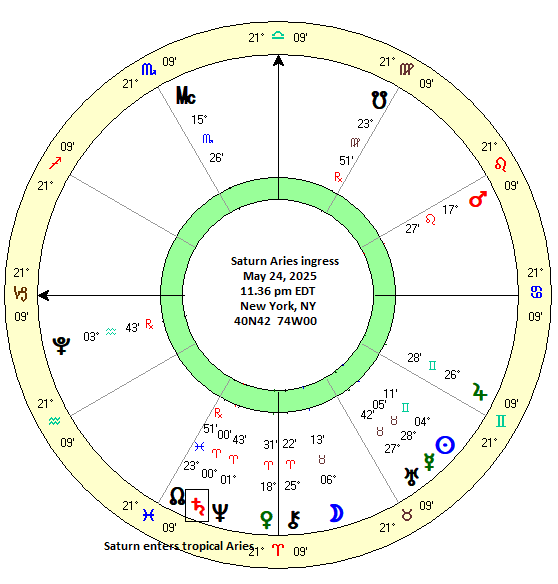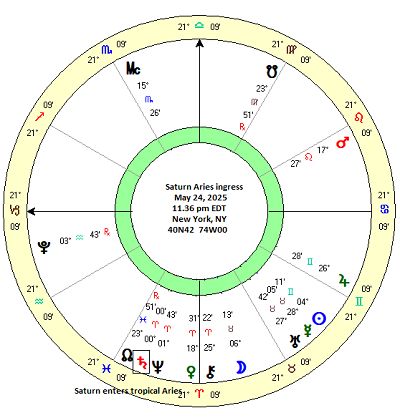 (27 April 2025) The concept of planetary ingress is central to most branches of astrology. It refers to the entry or ingress of a planet into a new zodiac sign where it may become subject to a different influence. Planetary ingresses are believed to signal shifts in energies as a planet’s intrinsic characteristics are modulated through the sign it now occupies. However, there are differing opinions about the significance of ingresses. Some astrologers focus on the specific time around the date of the ingress as an unstable period where changes may become manifest while others prefer to look at the medium term effect of the new sign for the duration of the planet’s transit.
(27 April 2025) The concept of planetary ingress is central to most branches of astrology. It refers to the entry or ingress of a planet into a new zodiac sign where it may become subject to a different influence. Planetary ingresses are believed to signal shifts in energies as a planet’s intrinsic characteristics are modulated through the sign it now occupies. However, there are differing opinions about the significance of ingresses. Some astrologers focus on the specific time around the date of the ingress as an unstable period where changes may become manifest while others prefer to look at the medium term effect of the new sign for the duration of the planet’s transit.
I think there is merit to both views. As a long-time adherent of the Vedic sidereal zodiac (Lahiri/Krishnamurti ayanamsha), I have observed the elevated possibility of significant events and shifts in sentiment in the days surrounding the exact date of a planetary ingress. The stock market crash of October 19, 1987 is the most famous example of this phenomenon which occurred the day after Uranus ingressed into sidereal Sagittarius. This was an unusual coincidence to say the least since Uranus changes signs about once every 7 years.
But I am an equal opportunity astrologer. The tropical zodiac is also relevant since its starting point of 0 degrees of Aries aligns with the date of the spring equinox in the northern hemisphere. While I don’t normally use the tropical zodiac for chart interpretation, I do acknowledge the possibility that it may yield useful information, especially in matters relating to sign changes. Lest my Vedic readers worry I’m switching teams, I would remind them that none other than the esteemed Indian astrologer B.V. Raman used tropical zodiac ingresses for his weather and earthquake predictions. Therefore, there may be no need to choose one over the other; we may well be better served by using both zodiacs when circumstances allow.
Tropical ingresses are in the spotlight this year since Neptune, Saturn and Uranus will all change signs. These shifts in underlying planetary energy may be one reason why the world feels a bit more chaotic than usual as these slow-moving planets take up residency in new zodiacal domains. Neptune entered tropical Aries on March 30, while Saturn will enter Aries on May 24. Uranus will enter tropical Gemini on July 7. All three of Neptune, Saturn and Uranus will make repeated ingresses of their signs due to their retrograde cycles later this year and in early 2026.
In this post, I wanted to focus on the Saturn ingress into tropical Aries on May 24, 2025. Actually, it is the first of three ingresses as Saturn will turn retrograde in July and again conjoin 0 Aries on September 1 on its way back into Pisces and then re-enter Aries for final time on February 13, 2026. There is good reason to be cautious about the possible impact of this ingress. The ingress comes at a time when financial markets have been very volatile after having declined substantially in March and April as a result of the new US tariff policy. As a bearish planet, any major change in the condition of Saturn has the potential to create havoc in the markets. Changing signs definitely qualifies as one such condition which could damage sentiment. Also, we should note that Saturn is considered debilitated in Aries and thus its ingress into the first sign of the zodiac carries with it an extra level of risk.
One of the challenges to analyzing the market effects of Saturn ingresses is accumulating a large enough sample size to make it meaningful. Saturn changes signs once every 2.5 years and thus one would have to look back over a 100-year period to create even a small sample of just 40 cases. And even then, there is still the problem of validity: is the ingress of Saturn into Pisces comparable in its effects to the ingress of Saturn into Aries? Since the Aries ingress is coming up next month, is it relevant to examine previous ingresses into Pisces, Aquarius and other signs? I hope to examine this question further in future posts.
For now, I wanted to reduce the sources of error as much as possible and focus solely with ingresses of Saturn into Aries. This creates an even bigger sample size problem. Saturn’s orbital cycle through the zodiac lasts 29-30 years. Since we only have reliable stock market data dating back to 1895, this means we can only measure the effects of four previous ingresses of Saturn into Aries. Obviously, there can be no basis for a proper statistical analysis with just four cases. And yet, there is something that stands out that may be pertinent to the 2025-2026 ingress cycle of Saturn.
The triple Saturn ingress of 1937
Looking at the tables of the closing prices of the Dow Jones Industrials, we can see that the Saturn Aries ingress is indeed bearish. The average percentage change is negative across all time intervals. But a closer look reveals huge divergences in the data. The 1908 and 1967 ingresses were actually quite positive as the market rose throughout the period before and after the ingress date. The 1996 ingress was more mixed but also registered positive outcomes for the interval 60 days before the ingress to 60 days after (-60d 60d) as well as for the 60 days leading up to the exact ingress (-60d 0d).
What stands out are the 1937-8 cases. Not only are they hugely negative, but that there are three of them close together. That’s because Saturn entered the first degree of Aries in April 1937 (marked “1 D” in the Cycle column meaning the first conjunction with 0 Aries while in direct motion) and then turned retrograde in July and exited Aries in October (Cycle = “2 R”) only to ingress for the third and final time in January 1938 (Cycle = “3 D”). This was the only ingress that featured three separate conjunctions with 0 Aries. The other three ingresses only occurred once during Saturn’s retrograde cycle did not produce multiple conjunctions with 0 Aries.
So we may ask the question: is the fact that Saturn had three conjunctions with 0 Aries a few months apart each somehow related to the fact that the market fell sharply during 1937-8? In fact, the bear market of 1937 saw stocks fall by 45%. It is important that we have a clear understanding of the triple ingresses of 1937 since 2025-6 will feature the same triple ingress of Saturn into Aries. Could history repeat?
Saturn alignments at the time of the ingress
With so few cases, we have to look elsewhere for confirmatory data. One obvious place is the 1937 transit chart itself. I have chosen the second retrograde ingress of October 17, 1937 since that corresponded the largest decline during that bear market. The key point here is that Saturn wasn’t just entering Aries in October, it was also in a close square aspect with Chiron (1 Cancer) and a near-exact 120-degree trine aspect with Pluto (0 Leo). The Saturn-Chiron square is sufficiently bearish in its own right that it would have coincided with a significant decline even if Saturn was not transiting over the 0 Aries point. It is possible that the combination of the Aries ingress and the alignments with Chiron and Pluto created the conditions for a massive market sell-off that year.
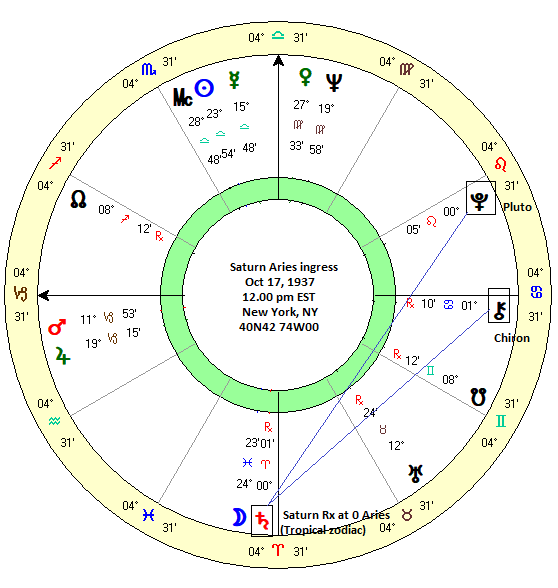
The Saturn ingress and the NYSE chart
But we can also look at how the 1937 Aries ingress of Saturn fit with the NYSE horoscope (May 17,1792). In order to take proper account of the precession of the equinoxes which shift the planetary positions by several degrees over a 200-year period, I am reverting back to the sidereal zodiac for this overlay chart. At the time of the October 1937 ingress Saturn (7 Pisces) is casting its full-strength third house/60 degree aspect to the Sun (6 Taurus) within just one degree. This is a significant affliction upon the NYSE chart and is another source of potentially negative sentiment. Again, we can speculate to what extent the bear market was due to the Aries ingress, the Saturn transit alignments with Chiron and Pluto, or indeed the alignment with the Sun in the NYSE chart.
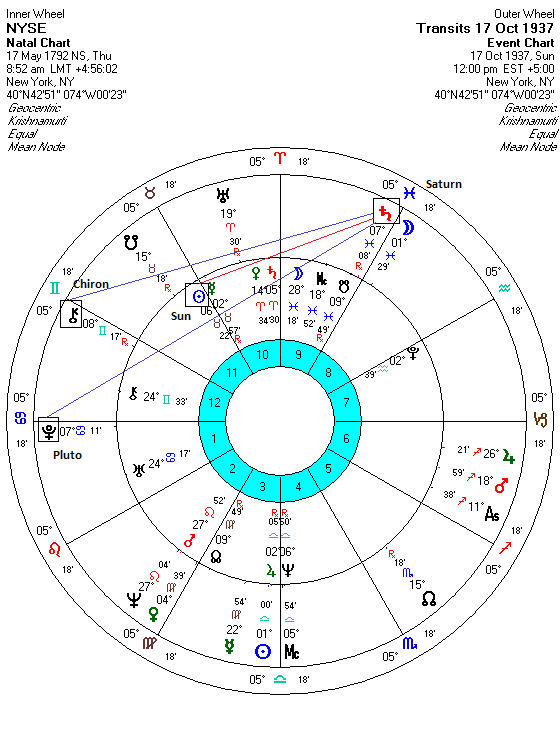
Looking ahead, we can see that Saturn’s ingress into Aries on May 24, 2025 will recreate the same full-strength 60 degree aspect of Saturn to the natal Sun in the NYSE chart. Moreover, since Saturn is due to station retrograde in July 2025 at 7 Pisces, it will remain within a very close alignment with the natal Sun from May until September. Given the bearish quality of Saturn-Sun aspects, this increases the probability of market declines during this time.
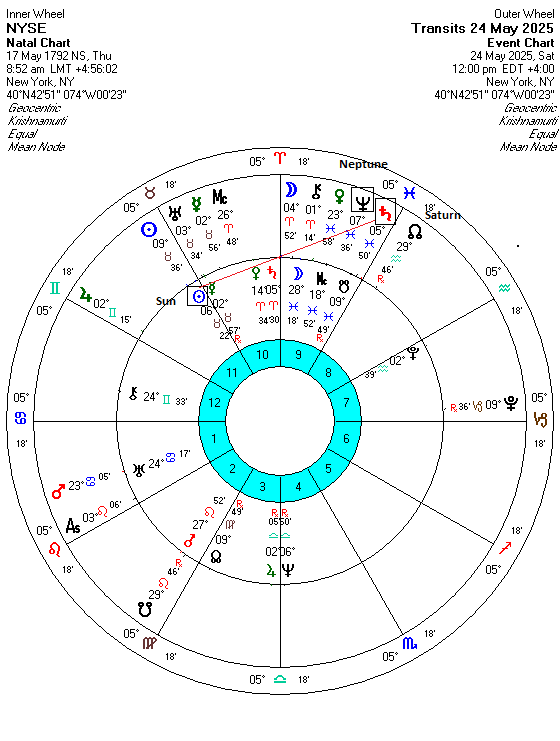
The triple Saturn ingress of 2025
This year’s ingress of Saturn into tropical Aries will feature three separate conjunctions with the sensitive 0 Aries point — on May 24, September 1, and on February 13, 2026. If 1937 is any guide, this triple ingress carries an added downside risk. Of course, a single case is no basis for making predictions and extrapolations, although it can raise our sense of caution. That is why we need to find other sources of evidence. As we’ve seen in the NYSE chart, it’s not just the Saturn-Sun aspect which occurs with every Saturn ingress into tropical Aries, but the fact that Saturn will station at 7 degrees of sidereal Pisces in July thus greatly prolonging the period of alignment. This should carry extra weight in our assessment. The other ingresses of 1908, 1967 and 1996 did not station near 7 Pisces and thus did not aspect the NYSE chart for a longer than normal time. This is likely one reason why those single Saturn ingresses were not negative and were even positive.
The other factor is the overall transit picture. Beside the ingress, we have to consider the other alignments that were in effect during the time of the Saturn ingresses. In 1937, there were no less than two very close and powerful alignments with outer planets (Chiron and Pluto) which greatly accentuated Saturn’s transit across the 0 Aries point. While it is difficult to distinguish how much effect each of these factors may have influenced the 1937 bear market, they each played a role.
For the 2025 triple ingress, we can see that Saturn will also be associated with outer planets. Saturn will be in close conjunction Neptune for all three ingresses. While the conjunction with Neptune is arguably less negative that Saturn’s square with Chiron in 1937, it does not seem bullish. By the time of the second ingress in September, Saturn will also form 60 degree alignments with Uranus and Pluto. As a general rule, 60 degree alignments with Saturn are considered less negative than 0, 90 or 180 degree alignments. But with Saturn in an unstable state around the very sensitive 0 Aries degree, these additional alignments with Uranus and Pluto may not prove to be mitigating factors. With Neptune remaining in a close conjunction with Saturn throughout 2025, there is good reason to be extra cautious with financial markets this year.
Conclusion
While the dearth of cases means the preceding cannot be called statistical research, it may still be considered empirical research. A study comprised of just 4 cases is not statistically relevant but our analysis suggests there are some potentially important commonalities between 1937 and 2025. Unlike the other Aries ingresses of Saturn in 1908, 1967 and 1996, the 1937 ingress featured no less than three conjunctions with 0 Aries. The 0 Aries point is arguably the most important point in the zodiac since it is location of the Sun at the time of the spring equinox on March 21. When Saturn conjoins 0 Aries it may be seen as resetting process as it commences anew its 29-year journey through the ecliptic. It is possible that Saturn’s multiple conjunctions with this point over a short time period could weaken or damage collective sentiment and thus coincide with lower than normal stock market returns.
As we approach the first of three conjunctions of Saturn and the 0 Aries point, we are well to ask if we will experience a similar impact this year. Certainly, this year’s alignments with Neptune, Uranus and Pluto roughly approximate the alignments of Saturn to Chiron and Pluto in 1937, even if they aren’t quite as foreboding. Nonetheless, the fact that Saturn will station at 7 Pisces in July in a near exact alignment with the NYSE Sun is another reason why markets could be vulnerable to more declines and head towards lower lows. Despite the recent rally in stocks and much-talked about “breadth thrust” which supposedly signals the all-clear sign, the triple ingress of Saturn into Aries this year could bring a return of volatility in the coming months. Stocks may therefore not only revisit their April lows, but could fall to lower lows later in the year.


